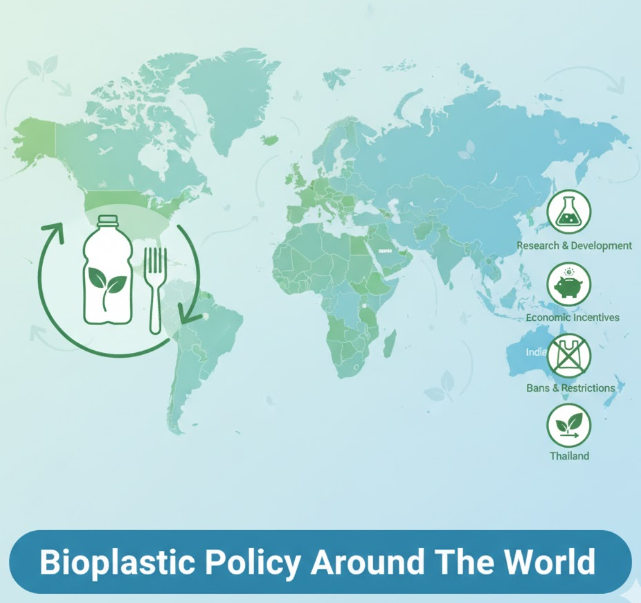What is the Bioplastic Policy and Regulatory Frameworks Around The World
Our world is drowning in plastic.
Last year, global plastic production hit over 460 million metric tonnes. Some estimates also point toward 400 plus million tonnes of waste annually and only a small fraction is being recycled.
As someone who’s spent years developing biodegradable products at Hemp Foundation, I’ve seen the potential of smarter materials up close.
Bioplastics (which are plastics made from plants or agricultural residues) hold a lot of promise. But they’re not a silver bullet.
Without clear rules and standards, even the best new materials can be misused or become part of the problem.
The global capacity is projected to hit 5.7 million tonnes by 2029. But growth alone doesn’t guarantee impact.
In fact, if we don’t have clear definitions and good policies, we could end up with even more confusion, greenwashing, or waste.
So, how are different countries responding? What laws and standards are in place for bioplastics around the world?
Before we explore this landscape, let’s clear up what we actually mean by “bioplastics.” It’s important to get the basics right.
What exactly are bioplastics?
When we talk about bioplastics, we’re really talking about a whole family of materials, not just one thing.
It’s important to remember this because the word “bioplastic” gets used a lot, sometimes without much clarity.
Not all bioplastics are equal and their properties can be very different. Let’s look at a few of the most common types:
- PLA (polylactic acid). These are made from plant products like corn starch, cassava or sugarcane.
- Bio-PE and Bio-PET are made partly or fully from renewable plants or agricultural waste. They perform exactly like their fossil-fuel counterparts and are not biodegradable.
- Starch-based bioplastics are made from corn, rice and potato. These cheap natural starches are turned into thermoplastic starch (TPS).
So bioplastics can be materials that are:
- Made from plants, or
- Made from fossil-based feedstock that are biodegradable
But how do we know which materials are bio-based?
Bioplastic carbon content is measured by the carbon atoms in the material. This radiocarbon dating technique is called the 14C (radiocarbon) test.
It checks what portion of the carbon inside the material came from renewable sources.
This method is standardized and recognized globally. In Europe, the standard is called CEN/TS 16137. In the US, it’s ASTM 6866. There are also independent certification labels like those from TÜV AUSTRIA (Belgium) and DIN CERTCO (Germany).
But if some bioplastics are non-biodegradable, how do they solve the massive waste problem? That is where certification and context come in.
Let’s look at the bioplastic regulations in major countries/regions around the world, starting with Europe.
How are bioplastics regulated in the European Union?
In November 2022, the European Union (EU) rolled out a detailed bioplastic policy framework. The “Policy Framework on Biobased, Biodegradable and Compostable Plastics” was part of the bigger European Green Deal and Circular Economy Action Plan.
The term “bioplastic” alone creates confusion. So, according to the EU’s policy framework, bioplastic products must:
- Mention if it is industrially compostable (in a controlled, high-heat facility) or home compostable. Or, if it only breaks down in specific soil conditions.
- Meet the same high standards as any other plastic. This is meant to prevent misleading claims or greenwashing.
However, the EU’s bioplastic policy is not a law yet. But there is some existing legislation that touches parts of the chain.
The EU’s Single-Use Plastics Directive has banned some single-use plastics (like cutlery and straws) and pushed brands to use certified alternatives such as PLA or starch-based plastics. There is yet to be a dedicated bioplastic law.
What about compostability?
The EU follows EN 13432 for industrial composting. Packaging that meets EN 13432 is certified as industrially compostable. TÜV AUSTRIA Belgium is another organization that checks for the EU composting standard with the ‘OK compost’ label.
But the important part is that industrial composting is a high‑temperature process. If you take that same packaging and drop it into a home composter or leave it littered in the open, you can’t assume it will fully break down. Many products certified under EN 13432 aren’t safe to claim “home compostable” unless separately certified.
Now, let’s look at the world’s largest plastic waste producer, the USA, and see how bioplastics are handled on the other side of the Atlantic.
Are there any bioplastic policies in the USA?
There is also no single, nationwide law for bioplastics in the USA. What we see is a patchwork of state regulations, local mandates, voluntary standards, and federal programmes.
Here’s how the landscape breaks down.
State
At the state level, some jurisdictions are ahead of the curve. For example, in California, legislation requires that disposable food‑service ware used on state properties be either recyclable or compostable.
It also requires that compostable items be certified by third parties.
The Biodegradable Products Institute (BPI) is the leading certification programme in North America. It verifies compostable plastics against recognised tests, such as ASTM standards.
Federal
On the federal side, the BioPreferred Program is run by the US Department of Agriculture (USDA). It promotes products made with renewable biological resources. It has also set mandatory purchasing requirements for federal agencies.
The USDA offers a voluntary biobased content certification for private products.
The country’s Federal Trade Commission (FTC) Green Guides also set rules against misleading claims (like calling something “biodegradable” without proof). But the system is inconsistent because every state can have different laws for:
- compostability,
- labeling,
- extended producer responsibility (EPR), and
- waste management.
If you look at Asia, especially India and China, the bioplastics regulation story is different again.
What’s happening with bioplastic regulation in India and China?
As you know, India has a massive plastic waste problem. To counter it, the country introduced the Plastic Waste Management Rules (2022, 2025) to ban multiple single-use plastics.
As part of this law, compostable plastics need to be certified by the Central Pollution Control Board (CPCB).
This means only materials that meet the IS/ISO 17088 composting standard can be sold as compostable according to India’s bioplastic policy.
Products that claim to be biodegradable are also required to have a CPCB-approved logo and a “COMPOSTABLE” label.
In China, bans on single-use plastics are also rolling out in stages. The country has also issued bioplastic regulations in terms of national standards for biodegradable plastics (GB/T 41010‑2021). These standards include:
- Minimum organic content requirements.
- Strict limits on heavy metals in biodegradable products.
- And mandatory labeling.
The bioplastic labeling rules in China require the product to print the specific bioplastic material and biodegradation conditions.
An example of a bioplastic label:
Overall, there are hundreds of millions of tons of agricultural and biomass waste sitting unused each year in Asia. It can feed bioplastic production. But the infrastructure for composting, recycling and enforcing standards still lags in many places.
Moving ahead
In essence, bioplastics do reduce fossil resources as they are often made from plants, not oil.
They also, in many cases, lower greenhouse gas emissions. Biobased plastics can even be carbon neutral when made from waste. Certified compostable plastics (like PLA) also divert food scraps and organic waste into composting. This returns the carbon to the soil.
But they are not a magical fix. Not all bioplastics are biodegradable and those that are not are often not home compostable. Most bioplastics need industrial composting. Moreover, composting and recycling facilities are not available everywhere, especially in developing countries like India.
But the systems around these materials must keep pace with the science. That’s the next big step.
So, bioplastic labeling rules must be clear. From our perspective at the Hemp Foundation, policies that reward biopolymers made from waste rather than food crops support rural incomes to rise alongside sustainability.
FAQs
What is a bioplastic policy?
A bioplastic policy is a government rule that guides how bioplastics are made, used, and managed at end of life. They are meant to replace single-use plastic packaging, especially in the food industry.
How do bioplastic policies support sustainable food packaging?
Strong bioplastic policies make sure food packaging is safe and clearly labeled. Meaning, products that are actually composted or recycled are sold to reduce pollution and protect health.
Are bioplastics always better than regular plastics?
Bioplastics have several benefits compared to fossil-fuel-based conventional plastics. But there is still a need for bioplastic laws by countries to enforce proper standards and invest in composting facilities.
What are the main gaps in current bioplastic regulation?
Most bioplastic regulations and labeling rules around the world lack harmonized safety standards, lifecycle testing, and real-world enforcement. This leaves a major room for greenwashing and waste mismanagement.
Why is certification important for bioplastics?
Bioplastic labeling rules and certification help prevent greenwashing and make it easier to recycle or compost bioplastic products correctly.
Vishal Vivek
Vishal Vivek is the Founder and CEO of Ukhi, a pioneering bio-materials company dedicated to ending plastic pollution by converting agricultural waste into high-performance compostable polymers. With a background in sustainable entrepreneurship and over a decade of technology experience, he leads Ukhi’s vision to create scalable, planet-positive material solutions. Previously, Vishal founded the Hemp Foundation, where he empowered more than 1,000 farmers and advanced sustainable livelihood initiatives. His work has been recognized through awards such as the HDFC Parivartan Grant and featured in leading publications like Forbes and Entrepreneur. Times Group recognized him as a legendary entrepreneur and published his biography in “I Did IT- Vol 2” alongside social pioneers like Bindeshwar Pathak (Sulabh International) and Anshu Gupta (Goonj). Vishal has authored more than 200 articles on sustainability and hemp, reflecting his deep expertise and advocacy for regenerative solutions. His commitment to grassroots impact led him to live in the remote mountains of Uttarakhand, where he immersed himself in the lives of marginal farmers, understanding their challenges and co-creating economic opportunities through hemp-based initiatives. A deeply passionate innovator, Vishal often draws inspiration from seemingly impossible achievements: “If Elon Musk can make rockets reusable, or Dashrath Manjhi can carve a path through a mountain with rudimentary tools, why can’t we eliminate the demon of single-use plastic while uplifting struggling farmers? We will make it happen—whatever it takes.” Ukhi is proud to be supported by premier institutions including IIT Guwahati, NSRCEL-IIM Bangalore, Indian School of Business (Hyderabad), Indian Council of Agricultural Research (ICAR Pusa), and the Indian Institute of Packaging. Vishal is committed to demonstrating that business can be a powerful catalyst for global environmental and social good. Connect with Vishal Vivek
Related Posts
Top Five Reasons to Use Hemp in Home Decor
What is it that makes it have a soul and style of its own? Well, there’s love and family, and ot
How Hemp Can Help Fight Global Warming
Global warming and climate change have become everyday words in contemporary public discourse. Neith
7 Major Fibers & Textiles In The World And Their Carbon Footprint
Ever considered how your clothes affect the environment? All clothes are made of fibers, but h



